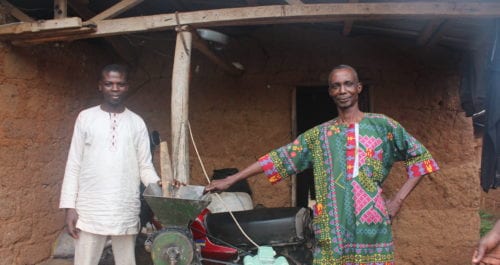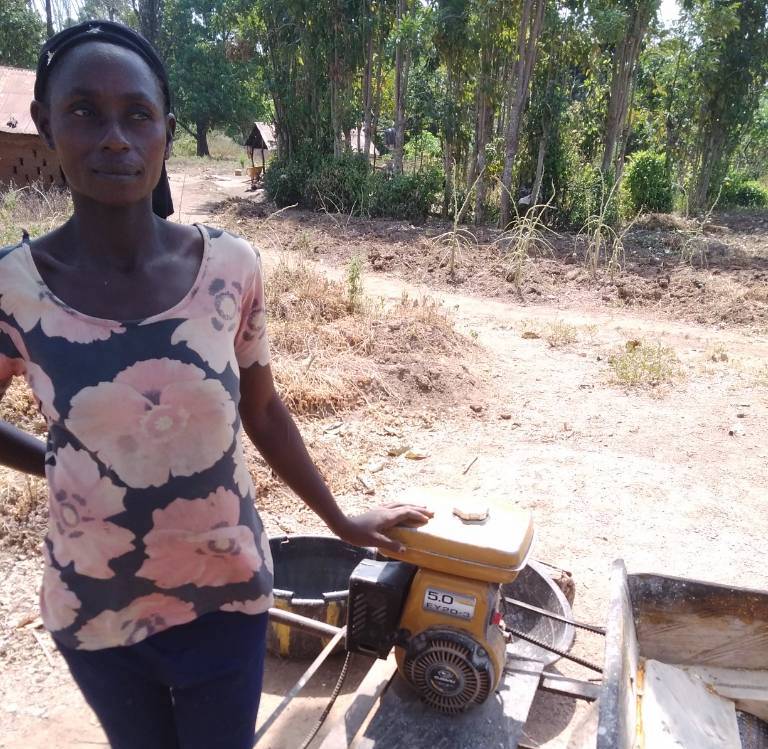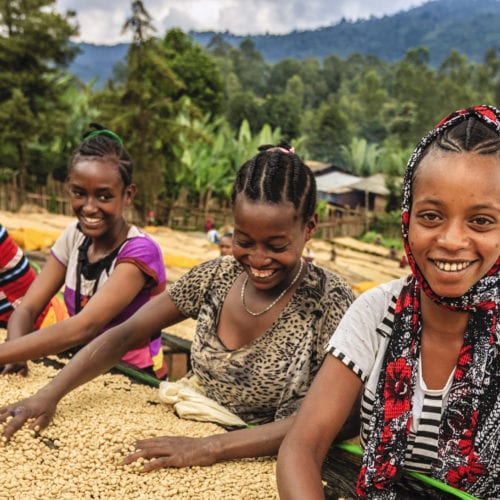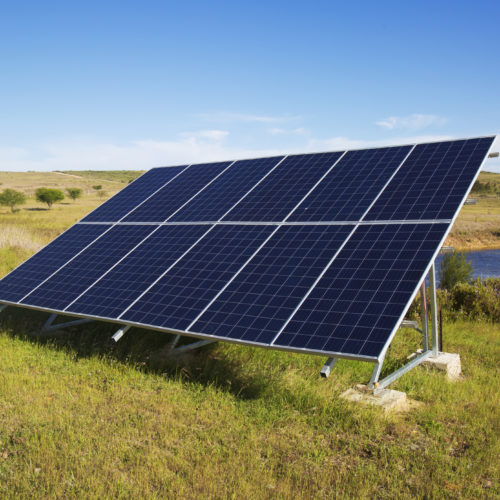David Babarinde with his retrofitted grain flour mill, which now runs on 24/7 electricity from a minigrid in Gbamu Gbamu community, Ogun state, Nigeria.

Synchronizing Agriculture and Distributed Energy Can Reduce Nigeria’s Oil Dependency
What if it was possible to boost both national and local economies while increasing energy access and saving rural residents money? That is exactly the opportunity in Nigeria, where COVID-19 impacts and the ensuing oil price collapse have made foreign exchange scarce, threatening an economy that relies heavily on this pool of currency.
But distributed energy resources (DERs), including solar minigrids, can reduce the cost of electricity in rural areas and are poised to similarly catalyze cost savings and quality improvements in Nigerian agriculture. Coordinating rural electrification and agricultural development efforts offers a clear pathway for oil-independent economic growth, including export diversification—an opportunity that extends across sub-Saharan Africa.
Nigeria’s economy depends on foreign exchange inflows from oil
The recent coronavirus-induced oil price crash is bad news for Nigeria’s oil-dependent economy. With oil prices expected to remain low, forecasters at McKinsey and the World Bank predict that Nigeria’s GDP will contract by between 3 percent and 9 percent in 2020.
Contrary to popular belief, Nigeria’s economy is not oil-dependent because it is undiversified: oil only accounts for about 10 percent of GDP, a smaller share than agriculture and manufacturing. Rather, oil dictates the direction of Nigeria’s economy because it provides over 80 percent of exports and, consequently, most of Nigeria’s foreign exchange earnings.
Nigerian businesses rely on foreign currency from oil exports to import raw materials and equipment. When oil prices are low, the pool of currency available for exchange is smaller and more expensive, and Nigerian companies struggle to source the inputs they need. Thus, diversifying exports would decrease the entire economy’s sensitivity to oil prices and put the Nigerian economy on firmer footing.
Poor electricity access inhibits diverse exports from agriculture
Agriculture can contribute to this much needed diversification. Experts estimate that Nigeria’s agricultural sector, which provides 23 percent of the country’s GDP and employs two-thirds of the labor force, has the potential to generate $40 billion in exports. But despite this potential, Nigeria exported under $1 billion in agricultural products in 2019—less than 1.4 percent of total exports.
Although electricity is not the sole ingredient in viable agricultural export markets, it is a necessary one. Getting exportable agricultural products from a rural community to an export market requires seamless operation of complex agricultural value chains. But today, poor access to electricity applies friction across the entire agricultural value chain, increasing costs and hampering the export potential of Africa’s largest producer of maize, cassava, and rice, among other crops.
Mary Oko, a farmer in an off-grid community in Cross River State, spends evenings in darkness. Without refrigeration, her tomato harvest is spoiling as she awaits a buyer. Her husband’s rice harvest is down this year because a dry spell hit just after planting, and theirs is part of the 99 percent of Nigerian agricultural land lacking access to irrigation. The fuel costs alone for a diesel irrigation pump would overtax their seasonal earnings from farming, and besides, there is no chance of getting a loan to buy one. Her family also runs a petrol-powered cassava grater that is perpetually down for repairs.
Down the road, a local rice miller overspends on diesel to keep an inefficient, thirty-year-old mill running—though it shatters as many grains as it polishes. After a local trader buys the rice, he sells to a wholesaler who cannot afford to purchase or power a new de-stoning or grain sorting machine to improve the quality of their milled rice and so they sell their inventory to local markets instead of higher-paying exporters.

Distributed energy resources, energy access, and agricultural productivity
Despite electricity’s role in ensuring the smooth operation of agricultural value chains, only 36 percent of rural Nigerians, most of whom are farmers, have access to grid electricity. Even for those with grid access, power could be available for as little as two hours per day. Rural communities are often distant from existing powerlines, sparsely populated, and demand fewer kilowatt-hours of electricity than denser urban neighborhoods. Thus, it is often unprofitable to build long distribution lines to reach these smaller load centers.
But this does not mean these communities have to remain unelectrified; distributed energy resources (DERs) such as minigrids and solar home systems can enable cost-effective electrification of rural areas. Today solar hybrid minigrids can provide 24/7 power at prices competitive with fossil fueled generators, and are projected to become cheaper still. However, without programs to support use of this electricity for productive activities, minigrids struggle financially.
Agriculture is the backbone of rural Nigerian economies, and productive uses of electricity powered by DERs can boost earnings for local farmers and processors while supporting the DER financially. Many processing activities, such as flour milling, cassava grating, and rice milling are mechanized in off-grid communities today. But most processors overspend on fuel and maintenance for aging, inefficient fossil-powered equipment.
RMI analysis finds that electrifying these activities with a minigrid can reduce costs and increase revenues for local operators. The yield increases, cost savings, and quality improvements brought by productive uses of electricity can improve competitiveness of Nigerian produce on export markets, which can enable increased exports if paired with supportive trade policy and infrastructure.
Since productive activities like these are performed during the day, when solar-based DERs are generating an abundance of cheap electricity, this demand can be met without an increase in expensive battery storage or backup generator capacity. These activities also increase revenue for the DER provider, allowing them to recoup costs at a lower tariff and benefit the entire community.
Coordinating electrification and agricultural development efforts
In the 1930s, low-interest loans to support rural electrification in America helped to increase output per farm, output per acre, and land values in the electrified communities. Crucially, these programs paired electricity access with the tools to do something useful with it.
For rural electrification in Nigeria to have a similar transformative effect, farmers must be able to purchase modern, efficient appliances that make use of their electricity access. However, because of low financial inclusion rates in rural Nigeria, many rural farmers are unable to access commercial credit to buy equipment. To bridge this gap, agricultural support programs from the Nigerian government, development finance institutions, and donors often involve provision of low-interest loans for equipment purchases or outright donations of equipment.
But despite clear complementarities between these programs and rural electrification efforts, they are often isolated from each other, resulting in sub-optimal outcomes. For example, a rural electrification program might build a minigrid in a community without any kind of appliance procurement support for its customers. Or an agricultural appliance program may supply equipment that uses fossil fuels or is incompatible with the minigrid. In this case, farmers must still travel long distances to buy expensive diesel to power the equipment while the minigrid suffers financially due to low electricity sales. To avoid such situations, stakeholders supporting rural electrification or agriculture must work together.
DERs are poised to catalyze cost savings and quality improvements in Nigerian agricultural production, which is a first step toward improving competitiveness in export markets. But for electrification to have a truly transformative effect on productivity and incomes, electrification efforts must be accompanied by efforts to link energy access to agricultural value chains. In doing so rural electrification will not only improve the livelihoods of rural Nigerians but also contribute to creating a less oil-dependent Nigeria.

